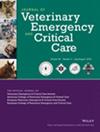Evaluation of a whole blood point-of-care coagulation analyzer in dogs
Abstract
Objective
To compare the accuracy of a point-of-care coagulation analyzer (POCCA) with a reference laboratory coagulation analyzer (LabCA) and to evaluate for confounding factors that could alter the performance of the POCCA.
Design
Prospective, observational study.
Setting
Two university veterinary teaching hospitals.
Animals
Forty-three client-owned dogs undergoing coagulation testing between April 2020 and June 2021.
Methods
Samples were obtained from dogs undergoing coagulation testing as part of a diagnostic workup. Prothrombin time (PT) and activated partial thromboplastin time (aPTT) were measured on the POCCA and on the LabCA. PCV, platelet count, total plasma protein, hyperbilirubinemia, hemolysis, lipemia, and autoagglutination were recorded.
Results
Moderate correlation was seen for PT and strong correlation was seen for aPTT between the POCCA and the LabCA (PT: 0.59, P < 0.0001; aPTT: 0.71, P < 0.0001). The POCCA results were consistent with normal or hypocoagulable samples for 30 of 38 PT and 33 of 37 aPTT results, as identified by the LabCA. Samples with PCV of 30%–55% were moderately correlated (PT: 0.63, P = 0.0004; aPTT: 0.63, P = 0.0003), but those outside that range were more likely to register an error message on the POCCA or provide disparate results. When hemolysis was present, there was a weak correlation between the POCCA and the LabCA for PT (rho: 0.38 [95% confidence interval: 0.19–0.76], P = 0.18) and a strong correlation for aPTT (rho: 0.86 [95% confidence interval: 0.62–0.95], P < 0.0001). Samples with hyperbilirubinemia were strongly correlated for PT (0.97, P = 0.002) but not for aPTT. Lipemia and autoagglutination were not observed.
Conclusion
There was an acceptable correlation in patients with PCV within the manufacturer's recommended reference range; however, measurements on samples with PCV outside the reference range were inconsistent with the LabCA. Caution should be used when using the POCCA in patients with coagulopathy and anemia or other potential confounders.

 求助内容:
求助内容: 应助结果提醒方式:
应助结果提醒方式:


